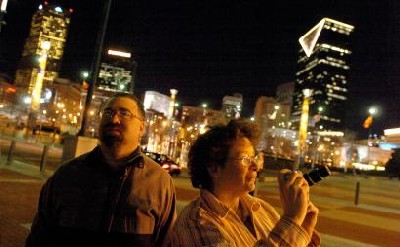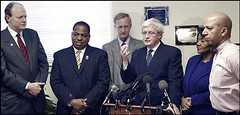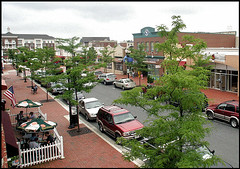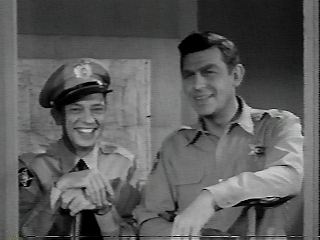Dog and pony shows and center cities vs. suburbs in perception management
 Photo: Joey Ivansco / Atlanta Journal-Constitution. Bill and Kathy Kemick of Columbia stroll through Centennial Olympic Park on Monday night. They say they feel safe in the heart of Atlanta.
Photo: Joey Ivansco / Atlanta Journal-Constitution. Bill and Kathy Kemick of Columbia stroll through Centennial Olympic Park on Monday night. They say they feel safe in the heart of Atlanta.NASCAR, the stock car racing organization, had a competition between Richmond, Kansas City, Atlanta, Charlotte, and Daytona Beach for the location of a new NASCAR Hall of Fame and theme park equivalent. A month or two ago, Richmond, home of one of the big races, and Kansas City, were eliminated. This week, NASCAR announced that Charlotte, home to many of the NASCAR racing teams, will be the location, rather than Daytona Beach, which is home to one of the major tracks and events, as well as the organization's headquarters.
The growth machine cynical part of me figures this dog and pony show was done in order to get the various jurisdictions to play off each other and offer better deals. Compare this with the debacle between the City of Washington and Major League Baseball over a stadium. As Marc Fisher wrote today in the Post, in "Ballpark Deal's Salvation? Both Sides Chickened Out ":
Baseball took a good look at its alternatives to Washington and came up empty. Northern Virginia would love to have the team. But finding a stadium site would be tough, and the state had zero interest in paying for a ballpark. The other cities that want baseball are so much smaller and less affluent that the sport's executives aren't even sure about whether to move the failing Florida teams to those hungry new markets.
Washington, on the other hand, is the dream sports market, jam-packed with disposable income and a relatively moneyed African American fan base to win over -- should baseball ever get serious about reaching out to blacks it has lost over the past generation. From baseball's perspective, the deal with the District had to work, or else the Nationals franchise would be as good as dead. " ...
 A meeting of the "Club for Growth?" Photo: Preston Keres, The Washington Post. Caption: Bill Hall, left, of the D.C. sports board; D.C. Council members Vincent B. Orange Sr. and Jack Evans; board Chairman Mark H. Tuohey , D.C. Council Chairman Linda W. Cropp; and Mayor Anthony A. Williams discuss the deal.
A meeting of the "Club for Growth?" Photo: Preston Keres, The Washington Post. Caption: Bill Hall, left, of the D.C. sports board; D.C. Council members Vincent B. Orange Sr. and Jack Evans; board Chairman Mark H. Tuohey , D.C. Council Chairman Linda W. Cropp; and Mayor Anthony A. Williams discuss the deal.Richmond and Atlanta are in the heartland of the greatest number of potential fans, while Kansas City is too far afield. Probably, NASCAR believes it can get more value by locating this attraction somewhat further north, within easy driving distrance reach of far more people likely to visit than Daytona Beach.
The only reason I'm writing about this is because some of the justification for NASCAR not choosing Atlanta, which has more "traditional center city" aspects than it likes to admit, is that it is unsafe at night, which is one of those legitimate criticisms, particularly with regard to "perception management" that center cities have to deal with all the time, and to some extent, more than is warranted. (See "Atlanta feels mugged by talk it was too dangerous to pick," from the Atlanta Journal-Constitution, registration required.)
However, it's like plane crashes. Statistically, airplane flight is extremely safe. The problem is that accidents tend to be catastrophic, where everyone dies. Similarly, center cities tend to experience some particularly gruesome crimes, or at least, because the major metropolitan media are located in the center cities, such events get more coverage, even if equally gruesome crimes happen in the suburbs. (Cf. New York Post, New York Daily News.)
One perfect example of this is the "Washington" sniper. One, one!, of the murders occured in the center city proper, and just barely on the edge of the city at that. All the rest were in the suburbs or exurbs (if it's fair to count Fredericksburg, Virginia, a city in its own right, as an appendage of Washington).
Think how much negative publicity the City of Washington proper has to live down over this. Yet, five of the murders occured in Montgomery County, Maryland, one of the primary regional destinations to realize the suburban idyll of "the American Dream."
 Kentlands in Gaithersburg. Washington Post photo by Bill O'Leary.
Kentlands in Gaithersburg. Washington Post photo by Bill O'Leary.The photo shows a small town feel with a bit of urbanism, and seemingly, little crime, or at least different crime from the "center city." Compare this with yesterday's Post article, "Marijuana Scam's Deadly Outcome Leaves Md. Family Anguished," about two murders of Montgomery County youths in Montgomery County when they sought to buy marijuana.
The "suburban idyll" has its antecedents in the warm and fuzzy memories of what people believe to have been true about small town America (small towns have always been fundamentally different from the newer and higher density, automobile-centric, suburbs of the center cities).
But small town America, and the suburbs probably have never been what people "remember." This makes it doubly difficult for center cities to compete on a level playing field as we not only have to compete against reality, but false memories as well.
 Deputy Barney Fife and Chief Andy Griffith in Mayberry, North Carolina. (Image from television's "Andy Griffith Show")
Deputy Barney Fife and Chief Andy Griffith in Mayberry, North Carolina. (Image from television's "Andy Griffith Show")________
From the Journal-Constitution article:
Charlotte vs. Atlanta
Both cities have a high security risk based on the amount of crime within a three-mile radius of the proposed sites, according to Cap Index, the world leader in crime vulnerability and loss prevention analytics.
Cap Index assigns a numerical score to represent the overall risk of crime in a given geography. For instance, Cap Index assigned Charlotte's site a score of 634, which means the risk of crime is 6.3 times higher than the national average in the area immediately surrounding the hall of fame; Atlanta's score was 803, or eight times the national average.
The maps show the Cap Index score for each Census tract within a one-mile -- or 25,000 population -- and three-mile -- or 100,000 population -- surrounding each proposed site. Atlanta's outer ring stopped at 2.26 miles because the area surrounding the proposed site is more densely populated than that of Charlotte. Atlanta map, Charlotte map
Cap Index Backgrounder
Index Keywords: stadiums-arenas



0 Comments:
Post a Comment
<< Home